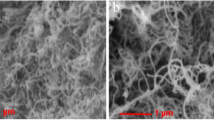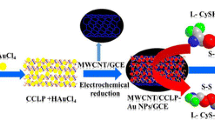Abstract
A highly sensitive, selective and cost effective method is described for sensing dopamine (DA) and uric acid (UA). A glassy carbon electrode (GCE) was modified with a nanocomposite consisting of gold nanoparticle-loaded multi-walled carbon nanotube (CNT) modified with 1-pyrene carboxylic acid (PCA). The stable aqueous dispersion of non-covalently functionalized CNT-PCA is an efficient bioprobe for the ultra sensitive and selective detection of dopamine and uric acid in the presence of the potentially interfering agent ascorbic acid (AA). The presence of PCA on the CNT introduces anionic carboxyl groups which repel ascorbate. The presence of the pyrene group augments high electrocatalytic activity towards oxidation of DA and UA, and the gold nanoparticles contribute to the amplification of the signal. The modified GCE gives an excellent peak current with well distinguishable peaks for AA, DA and UA (near −0.08 V, +0.14 V, and +0.22 V vs Ag/AgCl) in differential pulse voltammetry. Chronoamperometric detection of DA (working potential of 0.16 V vs Ag/AgCl) and UA (working potential of 0.3 V vs Ag/AgCl) showed linear ranges of 1 nM-150 μM (LOD 1 nM) and 1 μM–240 μM (LOD 1 μM) for DA and UA, respectively. The nanoprobe was validated by monitoring the recovery of spiked DA and UA in human blood serum samples which indicated a recovery within ±2%.

A glassy carbon electrode modified with a gold nanoparticle-loaded multi-walled carbon nanotube (CNT) - 1-pyrene carboxylic acid (PCA) composite was used for the sensitive and selective detection of the dopamine and uric acid.







Similar content being viewed by others
References
Martin C (1998) The Parkinson’s puzzle. Chem Br 34:40–42
Wightman RM, May LJ, Michael AC (1988) Detection of dopamine dynamics in the brain. Anal Chem 60:769A–793A
Heinig M, Johnson RJ (2006) Role of uric acid in hypertension, renal disease, and metabolic syndrome. Cleve Clin J Med 73:1059–1064
Chih Y-K, Yang M-C (2013) An 2,2′-azino-bis(3-ethylbenzthiazoline-6-sulfonic acid)-immobilized electrode for the simultaneous detection of dopamine and uric acid in the presence of ascorbic acid. Bioelectrochemistry 91:44–51
Ghanbari K, Moloudi M (2016) Flower-like ZnO decorated polyaniline/reduced graphene oxide nanocomposites for simultaneous determination of dopamine and uric acid. Anal Biochem 512:91–102
Tavakolia E, Tashkhourian J (2018) Sonication-assisted preparation of a nanocomposite consisting of reduced graphene oxide and CdSe quantum dots, and its application to simultaneous voltammetric determination of ascorbic acid, dopamine and uric acid. Microchim Acta 185:456–464
Liu M, Chen Q, Lai C (2013) A double signal amplification platform for ultrasensitive and simultaneous detection of ascorbic acid, dopamine, uric acid and acetaminophen based on a nanocomposite of ferrocene thiolate stabilized Fe3O4@Au nanoparticles with graphene sheet. Biosens Bioelectron 48:75–81
Tang C, Tian G, Wang Y, Su Z, Li C, Lin B, Huang H, Yu X, Li X, Long Y, Zeng Y (2009) Selective response of dopamine in the presence of ascorbic acid and uric acid at gold nanoparticles and multi-walled carbon nanotubes grafted with ethylene diamine tetraacetic acid modified electrode. B Chem Soc Ethiopia 23(3):317–326
Hou Y, Sheng K, Lu Y, Ma C, Liu W, Men X, Xu L, Yin S, Dong B, Bai X, Song H (2018) Three-dimensional graphene oxide foams loaded with AuPd alloy: a sensitive electrochemical sensor for dopamine. Microchim Acta 185:395–404
Zhao P, Chen C, Ni M (2019) Electrochemical dopamine sensor based on the use of a thermosensitive polymer and an nanocomposite prepared from multiwalled carbon nanotubes and graphene oxide. Microchim Acta 186:134–143
Wang Z, Guo H, Gui R (2018) Simultaneous and selective measurement of dopamine and uric acid using glassy carbon electrodes modified with a complex of gold nanoparticles and multiwall carbon nanotubes. Sensors Actuators B Chem 255:2069–2077
Patrice FT, Qiu K, Zhao L-J Individual Modified Carbon Nanotube Collision for Electrocatalytic Oxidation of Hydrazine in Aqueous Solution. ACS Appl Nano Mater 1:2069–2075
Huang B, Liu J, Lai L, Yu F, Ying X, Ye B-C, Li Y (2017) A free-standing electrochemical sensor based on graphene foam-carbon nanotube composite coupled with gold nanoparticles and its sensing application for electrochemical determination of dopamine and uric acid. J Electroanal Chem 801:129–134
Liu J, Xie Y, Wang K, Zeng Q, Liu R, Liu X (2017) A nanocomposite consisting of carbon nanotubes and gold nanoparticles in an amphiphilic copolymer for voltammetric determination of dopamine, paracetamol and uric acid. Microchim Acta 184:1739–1745
Lingyan J, Xia G, Lisha W, Qi W, Zhichun C, Xianfu L (2013) Electrochemical activation of polyethyleneimine-wrapped carbon nanotubes/in situ formed gold nanoparticles functionalised nanocomposite sensor for high sensitive and selective determination of dopamine. J Electroanal Chem 692:1–8
Jia D, Dai J, Yuan H, Lei L, Xiao D (2011) Selective detection of dopamine in the presence of uric acid using a gold nanoparticles-poly(luminol) hybrid film and multi-walled carbon nanotubes with incorporated β-cyclodextrin modified glassy carbon electrode. Talanta 5:2344–2351
Sun C-L, Chang C-T, Lee H-H (2011) Microwave-assisted synthesis of a core–shell MWCNT/GONR heterostructure for the electrochemical detection of ascorbic acid, dopamine, and uric acid. ACS Nano 5:7788–7795
Xu H, Zeng L, Xing S (2008) Microwave-radiated synthesis of gold nanoparticles/carbon nanotubes composites and its application to voltammetric detection of trace mercury(II). Electrochem Commun 10:1839–1843
Wang S, Wang X, Jiang SP (2008) PtRu nanoparticles supported on 1-aminopyrene-functionalized multiwalled carbon nanotubes and their electrocatalytic activity for methanol oxidation. Langmuir 24:10505–10512
Ou Y-Y, Huang MH (2006) High-density assembly of gold nanoparticles on multiwalled carbon nanotubes using 1-pyrenemethylamine as interlinker. J Phys Chem B 110:2031–2036
Georgakilas V, Tzitzios V, Gournis D, Petridis D (2005) Attachment of magnetic nanoparticles on carbon nanotubes and their soluble derivatives. Chem Mater 17:1613–1617
Saha K, Agasti SS, Kim C (2012) Gold nanoparticles in chemical and biological sensing. Chem Rev 112:2739–2779
Huang Q, Zhang H, Hu S (2014) A sensitive and reliable dopamine biosensor was developed based on the Au@carbon dots–chitosan composite film. Biosens Bioelectron 52:277–280
Chen D, Tian C, Li X (2018) Electrochemical determination of dopamine using a glassy carbon electrode modified with a nanocomposite consisting of nanoporous platinum-yttrium and graphene. Microchim Acta 185:98–105
How GTS, Pandikumar A, Ming HN, Ngee LH (2014) Highly exposed {001} facets of titanium dioxide modified with reduced graphene oxide for dopamine sensing. Sci Rep 2014(4):5044
Guo Q, Wu T, Liu L (2018) Flexible and conductive titanium carbide–carbon nanofibers for the simultaneous determination of ascorbic acid, dopamine and uric acid. J Mater Chem B 6:4610–4617
Zhang C, Ren J, Zhou J (2018) Facile fabrication of a 3,4,9,10-perylene tetracarboxylic acid functionalized graphene–multiwalled carbon nanotube–gold nanoparticle nanocomposite for highly sensitive and selective electrochemical detection of dopamine. Analyst 143:3075–3084
Kokulnathan T, Anthuvan AJ, Chen S-M (2018) Trace level electrochemical determination of the neurotransmitter dopamine in biological samples based on iron oxide nanoparticle decorated graphene sheets. Inorg Chem Front 5:705–718
Aparna TK, Sivasubramanian R, Dar MA (2018) One-pot synthesis of Au-Cu2O/rGO nanocomposite based electrochemical sensor for selective and simultaneous detection of dopamine and uric acid. J Alloys Compd 741:1130–1141
Asif M, Aziz A, Wang Z, Wang W, Ajmal M, Xiao F, Chen X, Liu H (2019) Superlattice stacking by hybridizing layered double hydroxide nanosheets with layers of reduced graphene oxide for electrochemical simultaneous determination of dopamine, uric acid and ascorbic acid. Microchim Acta 186:61–72
Li Y, Jiang Y, Song Y (2018) Simultaneous determination of dopamine and uric acid in the presence of ascorbic acid using a gold electrode modified with carboxylated graphene and silver nanocube functionalized polydopamine nanospheres. Microchim Acta 185:382–391
Huang H, Yue Y, Chen Z, Chen Y, Wu S, Liao J, Liu S, Wen H (2019) Electrochemical sensor based on a nanocomposite prepared from TmPO4 and graphene oxide for simultaneous voltammetric detection of ascorbic acid, dopamine and uric acid. Microchim Acta 186:189–198
Acknowledgements
We thank Kerala State Council for Science, Environment and Technology (KSCSTE) and Department of Science and Technology (DST), India for the financial support to Nano Science Research Laboratory. B.P acknowledges University Grant Commission for the research fellowship.
Author information
Authors and Affiliations
Corresponding author
Ethics declarations
The author(s) declare that they have no competing interests.
Additional information
Publisher’s note
Springer Nature remains neutral with regard to jurisdictional claims in published maps and institutional affiliations.
Electronic supplementary material
ESM 1
(DOCX 1.27 mb)
Rights and permissions
About this article
Cite this article
Posha, B., Kuttoth, H. & Sandhyarani, N. 1-Pyrene carboxylic acid functionalized carbon nanotube-gold nanoparticle nanocomposite for electrochemical sensing of dopamine and uric acid. Microchim Acta 186, 672 (2019). https://doi.org/10.1007/s00604-019-3783-0
Received:
Accepted:
Published:
DOI: https://doi.org/10.1007/s00604-019-3783-0




